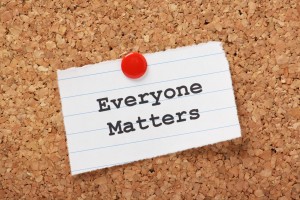Class rule: No putdowns, no exceptions… not by students or by the teacher.
Mat and Rick walk into the classroom putting each other down jovially. Friends, they often banter with each other for fun. Today, however, Matt’s teasing suddenly struck a tender chord with Rick. Rick flushed. Suddenly, they were pushing, shoving, and shouting angry words at each other. The friendly teasing has escalated to trouble.
 Sarcasm and putdowns are at best a risky source of humor in the classroom. Even if it never turns to blows, it could unwittingly cause hurt feelings or confuse students who have difficulty reading and interpreting social cues. Given a teacher’s inability to know how each student will react to sarcastic humor, a “no put down” rule can save a lot of heartache and, at the same time, create the foundation for a caring inclusive classroom community.
Sarcasm and putdowns are at best a risky source of humor in the classroom. Even if it never turns to blows, it could unwittingly cause hurt feelings or confuse students who have difficulty reading and interpreting social cues. Given a teacher’s inability to know how each student will react to sarcastic humor, a “no put down” rule can save a lot of heartache and, at the same time, create the foundation for a caring inclusive classroom community.
Why might some teachers or students resist this rule? Sarcasm and put-downs have become an acceptable form of entertainment and humor in our society. Because of this cultural acceptance, people, young and old, rationalize that it is OK to denigrate another person in the name of ‘teasing”, good-fun, and humor. Unfortunately, this belief system causes problems:
- • There are people, students included, who cannot read the difference between sarcastic humor and intentional meanness. Many learning disabled students are in this group.
- • Students learn best in a safe, non-threatening environment. How does the teacher draw the line between what is humor and what is bullying or mean?
- • I used to tell my students, “Even if someone laughs at your teasing, how do you really know what they are feeling? Would most students, especially male students ‘show’ their hurt?” I talked to a young woman with an eating disorder who shared with me “one line” someone said to her in the seventh grade that sent her into the spiral of the eating disorder. She could pinpoint the putdown to that moment in time. Also, remember the student shooter in San Diego? He laughed off the putdowns he had to endure. Then he showed up at school with a gun.
- • I ask, “How do we know that our words meant in fun are taken as they are meant?” Is it worth the risk?
- • What if we encouraged our students to share when words came across as putdowns even when the person using the putdown is the teacher? What kind of environment would that create in our classrooms?
- • Many adults who use sarcastic humor become very defensive when this rule is suggested. Why do you think that is? We need to ask ourselves, “What kind of room do I want to run? What kind of community do I want to create in my classroom? How do I achieve that?”
- • People who use sarcasm as humor are not bad people. Rather, they are conditioned by their upbringing or our media culture to enjoy it, accept it, and use it. Awareness is the first step to change.
What do you do when someone uses putdowns in the classroom?
- • Immediately address it. Remind students of the rule and of the goal of having a “safe place” in your classroom.
- • If repeated, have a private conversation with the offender. When appropriate, require restitution. For example: Student must give the person two kind comments for each putdown.
- • Enforce the classroom discipline policy.
- • If it’s you, the teacher, admit your mistake, apologize and try harder next time. You are making progress and creating positive change. Keep up the good work!

Bring Susan to your campus!
Featured seminar – Differentiation Strategies to Reach ALL Learners in the Inclusive Classroom
